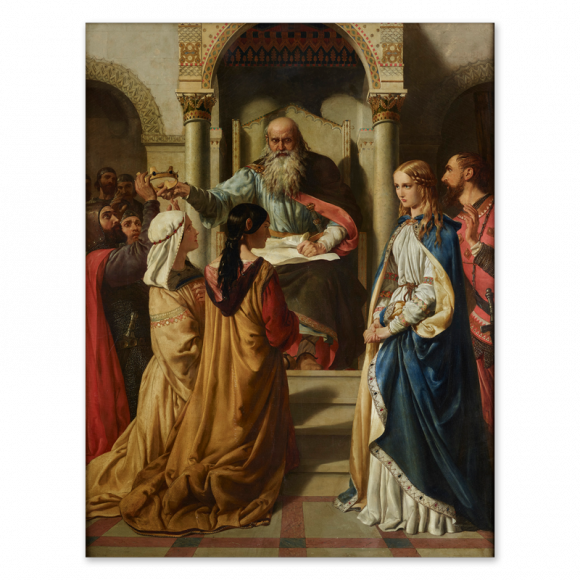J.R. Herbert was an important Victorian artist, who is best remembered today for his substantial murals in the Palace of Westminster and for the important influence he had on the emerging painters of the Pre-Raphaelite Brotherhood.
Trained initially at the Royal Academy his early work concentrated on fairly conventional genre subject matter.But around 1840 he became drawn to Catholicism and his work around that time leant markedly towards religious subjects. He started to show the considerable influence of the German Nazarene painters – the group of artists living in almost monastic circumstances in Rome in the first half of the 19th century.Their paintings, in the manner of the earlier Old Masters, impressed Herbert and he adopted something of their simple, clearly delineated style and their incisive detailing.Recognition of his abilities in this style saw him elected as an Associate of the Royal Academy in 1841 and as a full Academician in 1846.
Around this time he was also teaching at the Academy Schools and amongst his pupils were the young Millais, Rossetti and Holman Hunt.Inspired by Herbert’s religious and archaic subject matter and by his careful use of Nazarene line, they resolved to follow his lead and even go further, famously declaring that they would ‘out-Herbert Herbert’.He became a strong supporter of their work and, among others, came to their aid by using his influence at the R.A. to assist them during the infamous controversy that surrounded their early exhibits there.
But following the burning of the Old Houses of Parliament (1834) and the commissioning of the new Palace of Westminster, Herbert – undoubtedly helped and supported by his friend and fellow catholic the architect and designer A.W.N.Pugin – successfully won commissions to paint a number of murals for the new building.These, massively ambitious in their scale, were to occupy him on and off for some 20 years of his life.These murals have degenerated more than once into a precarious state of conservation, but recent restoration work has allowed them to be seen to advantage again.
This present picture is the substantial easel painting that Herbert made of the subject of King Lear disinheriting Cordelia, which he showed at the R.A. in 1849.He would complete his near identical mural of the same subject for the Palace of Westminster in 1850.In those years he also produced various studies of the figures for the mural and these he eventually sold as stand-alone works of art in their own right as well.
Herbert chose Act 1, Scene 1 of Shakespeare’s King Lear where Lear proposes to divide his kingdom between his three daughters according to how much they profess to love him.Unlike her two sisters, Cordelia, the one who genuinely loves him as a daughter should, states with disarming honesty that she cannot ‘heave her heart into her mouth’ in such an artificial way.Lear in a vain rage disinherits her.Herbert depicts Lear as an almost Michelangelesque figure from the Old Masters thundering from his throne – and Cordelia as radiantly beautiful girl, steadfast in her stance. Herbert’s positioning of one of Lear’s other daughters close to the figure of Cordelia, with an evil, scheming expression on her face, is a deft exercise in facial contrast.
Of other known works that Herbert produced of this subject, we note a good half-length study of Cordelia in the Harris Museum (1850), a study of the right hand side of this present picture centering on Cordelia (1850, Private Collection), and a later copy of the full mural/painting the Nottingham Castle Museum (1876).There can be no question that Herbert saw in Cordelia the innocence of a Virgin Mary.But it is also quite evident that in his presentation of this beautiful model with her long blond hair and her archaic robes and adornments we are also looking at a notable prototype for many an Ophelia, a Belle Dame Sans Merci or other medieval damsel.These beautiful female figures of myth and literature would become key to much Pre-Raphaelite work in the following decades.Herbert can in many ways with a picture like this be seen as their progenitor.

